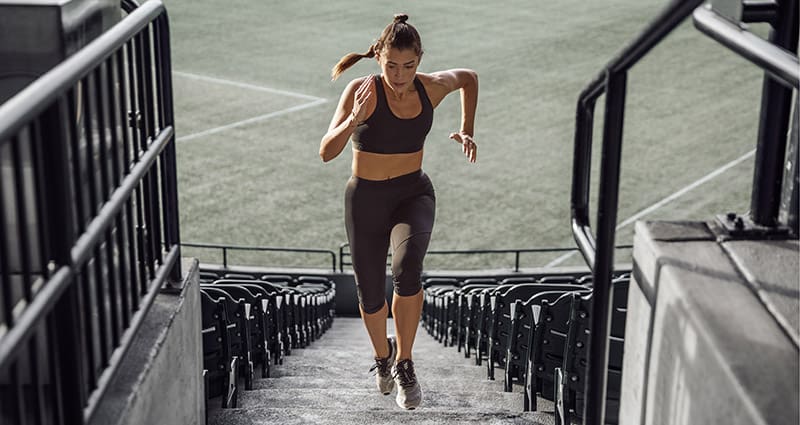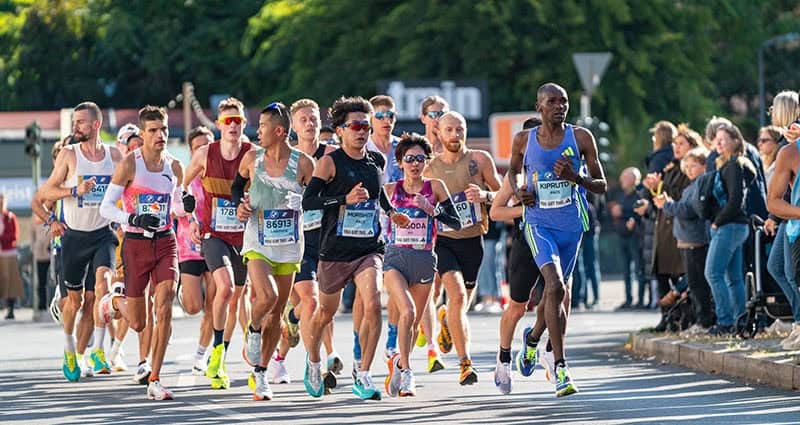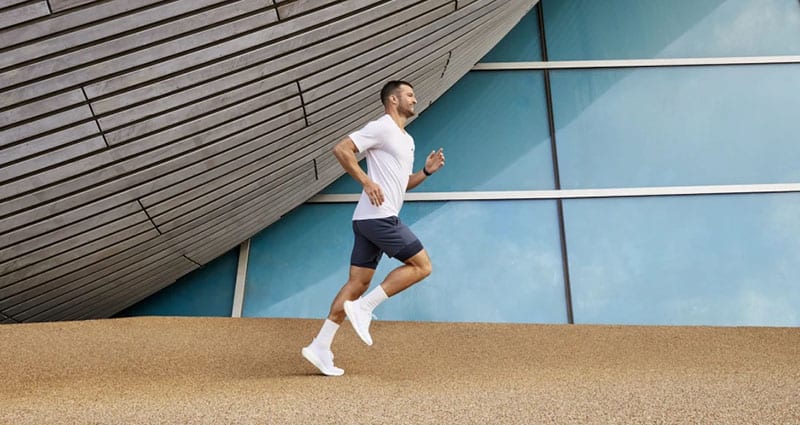Plyometrics for running dramatically improve economy in distance runners. And yet, few amateur athletes take advantage of this time-efficient training modality.
“Plyometrics dramatically improve your running economy.”
Top-level performance for sprinters and elite endurance runners is unthinkable without plyometric training. It adds power to the stride, improves running economy, and plays a role in injury prevention. You, too, should make it part of your training regimen.
What is Plyometric Training?
Plyometrics was developed for elite athletes in the 1950s. Originally known as “shock training,” it mainly consisted of high- to ultrahigh-intensity exercises such as weighted depth jumps. That’s often referred to as classic plyometrics. Modern plyometrics also employs a continuum of submaximal exercises at low to moderate intensity.
All plyometric exercises stimulate the activation of the stretch-shortening cycle (SSC), which is initiated when a muscle action is preceded by a quick countermovement. For example, if you want to jump as high as possible, you would quickly bend your knees first in the opposite direction to generate maximal power.
Popular lower body submaximal plyometrics for running are the Two-Foot Ankle Hop, Standing Long Jump, Tuck Jumps, Split Squat Jump, and Double-Leg Hops – to name a few. Running itself is a plyometric activity, while cycling and swimming are not.
The Benefits of Plyometrics for Running
When Usain Bolt ran his world record over the 100m dash, he did so with an average stride length of 8 feet (nearly 2,50 meters) with a cadence similar to us mere mortals. Strength alone doesn’t explain his outstanding stride length. He doesn’t beat Olympic lifters in the squat, not even the lower weight classes. Explosiveness sets him apart – the ability to impart power into the ground with a very short ground contact time. Although we are distance runners and not sprinters, a shorter ground contact time makes a difference as strides accumulate over the course of a 10K or a marathon.
But what moves the needle for distance running performance is running economy. Training the stretch-shortening cycle (SSC) with plyometrics enables you to run more efficiently, even during easy runs. It increases mechanical efficiency by temporarily storing elastic energy within tendons and muscles.
Plyometric training also reduces the risk of injury by fortifying your connective tissues – such as bones, tendons, ligaments, and cartilage – for the rigors of running. Another factor is improved landing mechanics that reduce the strain during running. In short, injury prevention alone is reason enough to make plyometrics part of your training routine.
Adding Plyometrics to Your Training
The best time to execute plyometrics is near the beginning of a workout when fatigue is minimal and energy levels are high. Start with an appropriate warm-up of 5 – 10 minutes of easy running followed by low-intensity drills such as high knees, butt kicks, skipping, and cariocas. Performing plyometrics in a pre-fatigued state after your main set is unwise and invites injury.
The exercise selection should be as specific as possible to the demands of running. That means lower-body plyometrics with vertical and horizontal movements. You don’t need any equipment for most plyometrics but stick to surfaces that facilitate proper energy return, like asphalt or synthetic rubber on a track. Stay away from uneven surfaces.
Also, don’t approach plyometrics with a more is better mentality. The quality of the workout is important and not quantity per se. Twice a week, 72 hours apart, is plenty for amateur runners to progress, while once a week, during phases of lower training volume, will at least offset any potential training effects. Start with one to two sets of 2 – 3 plyometric exercises and gradually progress to 4 – 5 over several weeks. The same applies to increasing the number of repetitions and sets. But again, quality over quantity.
Strength training is not a necessity for low-intensity plyometrics. But it would certainly augment your progress. Strength (force) is foundational to power (force x velocity). Hence, strength training and plyometric training complement each other.
If you are a master athlete (age 40 and above), you will greatly benefit from plyometrics for running. Muscular power deteriorates faster than strength loss with aging; therefore, attempts to maintain or improve power are beneficial to improving fitness. For masters, the same guidelines apply as for younger age groups, except that volume may be lower.
5 Plyometrics for Running
The following 5 plyometric exercises are low to moderate in intensity and can be performed without equipment. For low-intensity plyometrics, the rest-to-relief ratio between repetitions is 1:5. Take longer breaks between sets and exercises.
Two-Foot Ankle Hop (“Pogo”)
Begin with arms at the side and a shoulder-width stance. After a countermovement, jump straight up (with double-arm action), land, and explosively jump upright once again.
Standing Long Jump
Begin with arms at the side and a shoulder-width stance with knees slightly bent. Following a countermovement (and backswing of arms), jump as far forward as possible while using an explosive double-arm action. Pay attention to balance during landing.
Tuck Jumps
Begin with arms at the sides, shoulder-width stance, and knees slightly bent. After a quick countermovement (and backswing of arms), explosively jump vertically as high as possible using a double-arm action. While jumping, raise your knees to the chest and temporarily hold that position or grasp the knees with both hands.
Split Squat Jump
Begin with the arms at the side. One leg is flexed forward while the opposite hip is hyperextended, resembling a front lunge position. The front knee is flexed 45 – 90 degrees, whereas the back knee is slightly bent. After a short countermovement, explosively jump vertically while extending the arms upward. Land in the same position held prior to initiating the jump.
Double-Leg Hops
Begin with arms at the sides, shoulder-width stance and knees slightly flexed. Following a countermovement (and arm backswing), jump forward explosively, land, and repeatedly hop for a specific distance.





